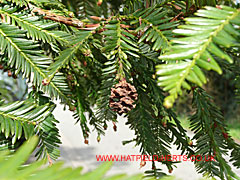Giant trees – Coast Redwood (Sequoia sempervirens)
Also called Coastal Redwood; California Redwood; Belongs to the Cypress family Cupressaceae – world's tallest living species (and probably the type of Sequoia filmed in Star Wars: Return of the Jedi).
The tallest living example in its native California is called Hyperion and is around 115m (377 ft). The species was introduced to Britain in 1843. However, they were spotted by Archibald Menzies, ship surgeon on Vancouver's 1791-95 expedition (the first European credited with 'discovering' them was Thaddeus Haenke). Sequoias or rather their relations were known through fossil finds before the living trees were discovered. The Coast Redwood was classed as Taxodium sempervirens in 1828. However, Austrian botanist Stephan Ladislaus Endlicher, disagreed with this classification and named in Sequoia sempervirens.
Sadly, Endlicher, who had been appointed professor of botany of the University of Vienna in 1840, apparently exhausted himself and his resources in advancing man's knowledge and understanding of the botanical world. He committed suicide in March 1849. Unfortunately, he apparently did not leave detailed notes about who or what he had in mind when he assigned the name Sequoia, which has led to some confusion and speculation.
Although then the largest tree known, when the seeds were sent to Britain in 1843 it did not cause much of a sensation (unlike the Giant Redwood, a decade later). Fortunately, this type of conifer has the ability to regenerate if cut down – and demand for timber for buildings and the railroad saw vast swathes cut down before protection was introduced in its native America. It is capable of reaching an age of 2,600 years old.
A specimen can be found growing in the Arboretum at Hatfield House. However, there also appears to be a specimen growing on Old Rectory Drive – close to a much larger Giant Sequoia (although it is possible that this is a different branch of the Redwood family – it is far smaller than its giant neighbour).

Conifer – thought to be a Coastal Sequoia – growing on Old Rectory Drive

Mature female cone

The leaves of the Coastal Redwood are markedly different from that of the Giant Redwood. However, they are similar to the Dawn Redwood. The key difference being that on the Coastal Redwood they alternate (on the Dawn Redwood they are opposing – on each side they join the stem at the same point). Young cones or leaf buds are visible in this expanded view of the picture above.

The bark is reddish and spongy – a characteristic of the Giant Redwood. However, the leaves clearly rule it out being one, and its relative softness may be due to its young age. Somewhat surprisingly, the Kew Garden website suggests punching the trunk as a method of telling a Coastal Redwood from a Giant Redwood – if it's soft it's a Giant; if you hurt your knuckles it's a Coastal.
Tip: checking the leaves is probably the least painful option: even if the canopy is too high, there should be dead leaves on the ground.